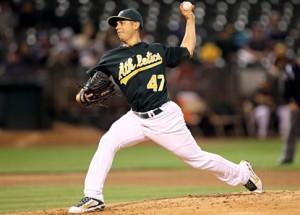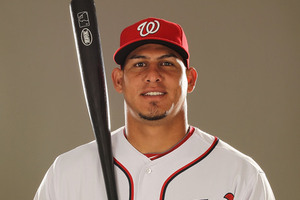
Gonzalez signs a long term deal; we're committed now. Photo Jed Jacobsohn/Getty Images via nydailynews.com
This is your semi-weekly/periodic wrap-up of Nats and other baseball news that caught my eye. Apologies for the delay in posting; new rules on laptop usage at work have thwarted my typical read-sports-news-at-lunch habits. I’ll have to get creative.
Nationals In General
- Nats extend Gio Gonzalez for 5 years. Terms: 5yrs, $42M with two more club options. A little more than $8m AAV, or in other words what we were paying Jason Marquis. I’m sure its backloaded somewhat, but I like the deal for two main reasons. First, we buy out all the arbitration years ahead of time and avoid the arbitration process altogether (which does nothing but serve to bruise the fragile egos of professional athletes over a few hundred thousand dollars of salary). Secondly, it locks up the player for the longer term and gives the team some stability for the next few years.
- Jim Callis at BaseballAmerica answered a question about what an updated Nats top 10 prospect list would look like post trade: he’d promote up Destin Hood, Chris Marrero, and Michael Taylor. Considering what Marrero’s prospect status is now, considering how long it has taken Hood to get the hang of playing baseball, and how far away Taylor is from the majors, I think its safe to say our farm system is officially “thin.”
- Nice little piece on Bryce Harper from Buster Olney, who relays the well known opinion that Davey Johnson really likes young superstars and predicts that Harper may break camp with the team. Why doesn’t anyone relay all the facts in this case? Like the fact that there wasn’t a concept of “Super-2” when Johnson promoted Gooden and Strawberry and there wasn’t a punitive financial issue lurking by doing so.
- Great news to see so many of our arbitration eligible guys settled well ahead of going in front of the arbitrator. These cases don’t help anyone in the long run and end up arguing semantics over a few hundred thousand dollars that the team can clearly pay.
- Though I havn’t seen any confirmation of this elsewhere, Bill Ladson reports that the Nats are engaged in extension talks with Ryan Zimmerman. If so, this comes at a relatively good time for the team to be doing the negotiating; Zimmerman’s value is as low now as it has been since before his rookie season, on account of multiple injuries and a lack of overall production. Which is exactly why I don’t think any long term deal is going to be struck this off-season frankly; Zimmerman would expect a Troy Tulowitzki like deal and I don’t think he’s done enough to earn it.
Free Agents/Player Transaction News
- The arbitration case to watch this coming off-season will be Tim Lincecum; he is asking for $21.5M for 2012, with the Giants offering $17M. Wow. There’s really no case like his out there to use as a precedent; if you think he should earn roughly 80% of his FA value, then $21.5M equates with an annual salary of $26.875/year AAV. That’s more than Cliff Lee, CC Sabathia or Johan Santana (the three highest paid pitchers at current). So I guess you have to ask yourself; is Lincecum the best pitcher in the league? Because he’s about to be paid in line with that title.
Hall of Fame items
- Not HoF specific, but inspired by it. David Shoenfield compiles a list of the best players by running 5-year WAR figures to show some enlightening information. WAR has some limitations over longer terms but I like what it shows for season-to-season value for players. His point was that some relatively unsupported hall of fame claims appear on these lists. For me the last couple periods showing guys like Chase Utley and Matt Holliday were kind of eye opening.
General Baseball News
- Phillies sign Joel Pineiro to a minor league deal. I know he struggled in LA last season, but at one point this guy was pretty decent. If he can regain his health and his St. Louis form, suddenly the Phillies might have themselves a pretty good 5th starter option to take mediocre innings away from Joe Blanton. I’m surprised they were able to get him on a minor league contract.
- I’ve read bits and pieces about the fall of Puerto Rican baseball before; but this is the first article i’ve seen that really delves into it deeply. Rob Neyer lists the cause and effect; baseball subjected Puerto Rican’s to the normal draft and almost immediately killed baseball in the country. This is the lesson/concern about going to an international draft; individual teams won’t cultivate and build off-site academies if they serve to build players who can be drafted by other teams. This is what happened in Puerto Rico and its probably what would happen in the Dominican Republic, Venezuela and other developing countries. Its a scary thought.
- Related to the above Puerto Rican story is this: Cleveland pitcher Fausto Carmona arrested in the Dominican Republic for falsifying his name and age ahead of his big signing. For all the lamenting of the above Puerto Rican situation … this is yet another example (see Gonzalez, Smiley for Nats fans) of the flip side of the lack of an international draft. Draft experts and scouting mavens lament the loss of Puerto Rican development and think that the exact same thing would happen in the D.R. if they were included in the draft, and yes its hard to argue differently. But the down side of having such a “lottery” for 15-16 yr old players in the impoverished D.R. is the continued fraud among players growing up there related to age falsification.
- Sabre-nerds may decry the lack of statistical science behind it, but Tom Verducci‘s annual “Year After” effect (which has come to be known as the Verducci-effect by others) has had an 84% success factor in predicting either injury or distinct decline in performance for his named pitchers. The most interesting names on the list are newly traded Michael Pineda, Jeremy Hellickson, and both Texas mid-rotation starters Matt Harrison and Derek Holland. Holland in particular threw a whopping 77 more innings this year over last.
General News; other
- Not that any of us needed to read any more about the Jerry Sandusky/Penn State Scandal, but reading Washington Post’s Sally Jenkins‘ front page story with Joe Paterno‘s first interview post-scandal was an interesting read. Frankly, I don’t buy some of the way the story reads (intimating that Paterno had “little to do” with Sandusky by the time the 2002 allegations came around, for example). It doesn’t seem like Paterno was really challenged in the interview. Gene Wojciechowski echos some of these sentiments in this analysis piece here, criticizing Paterno’s convenient stance on the scandal and on the multitude of other stories that have come out about his manipulation of the system and real influence at the university. The real problem is just the nature of dealing with a legend; he worked for Penn State for 61 years and made the university what it is; how do you possibly deal with such a figure, who clearly was larger than the university? Update: just prior to publishing this, Paterno lost his battle with lung cancer, a quick and unfortunate end to his legendary career. Its amazing to consider that just 3 months ago, Paterno was still the larger than life legend and nothing bad had ever happened on the campus.
- I’m sure the real story is somewhere in-between the original story and the “Update” at the end, but there seems to be enough truth in the former to not necessarily believe the latter. A new Utah high school’s board decided that the student-voted mascot name “Cougars” can’t be used because the name is derogatory towards middle-aged women who hook up with younger men. Seriously.
